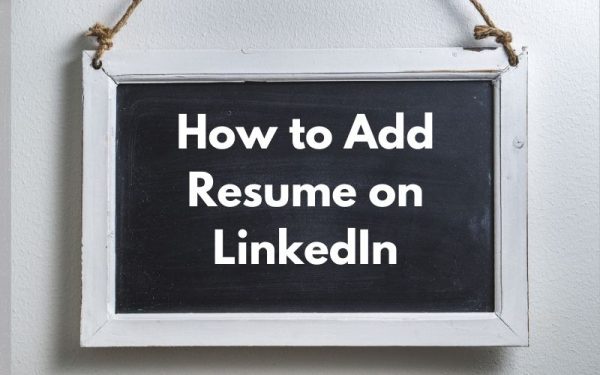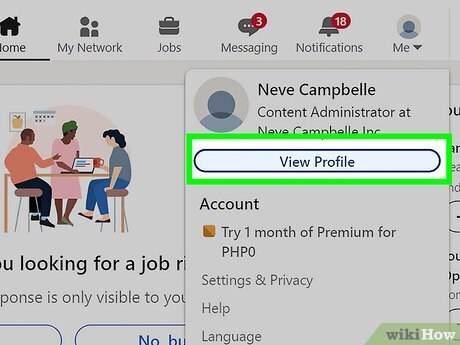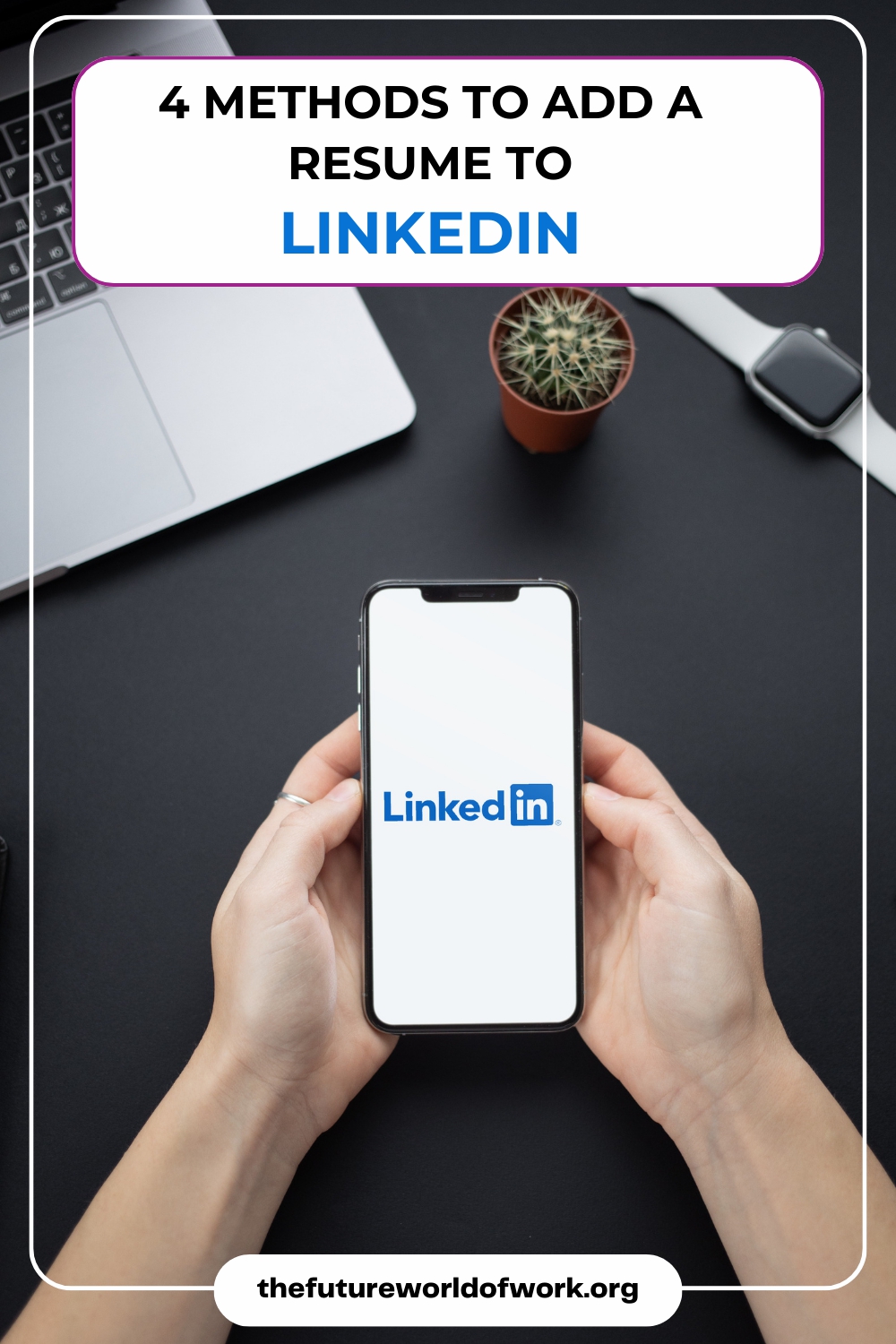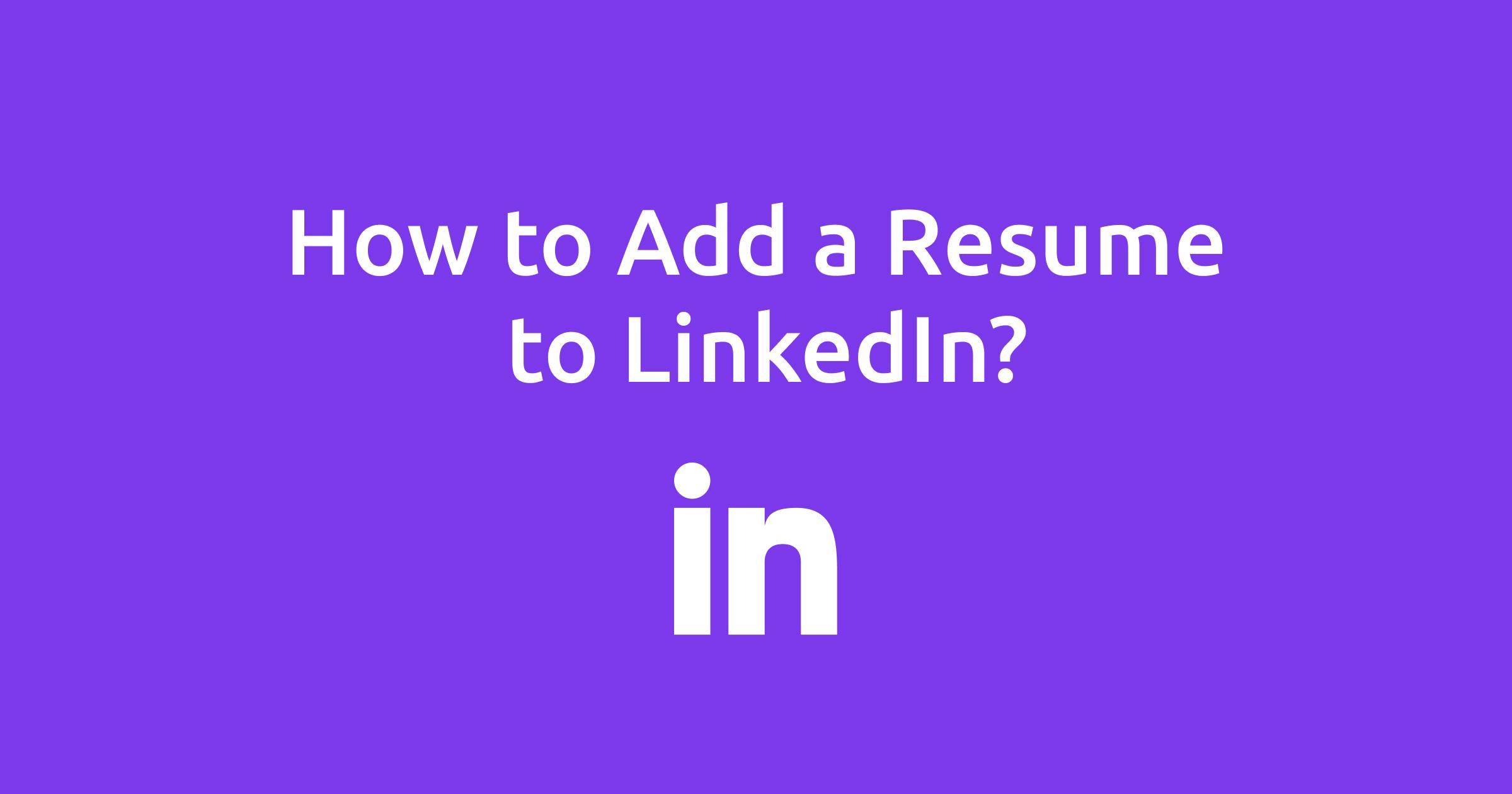Are you looking to enhance your LinkedIn profile and attract potential employers? Adding your resume is a powerful way to showcase your skills, experiences, and accomplishments. In this guide, we’ll walk you through the step-by-step process of uploading your resume to LinkedIn, ensuring you stand out in a crowded job market. Let’s dive in!
Why You Should Add a Resume to Your LinkedIn Profile

Now that you’re ready to upload your resume, you might be wondering: Why is it important to do so in the first place? Great question! Here are some compelling reasons:
- Increase Visibility: By adding your resume, you increase the chances that recruiters and hiring managers will find you. Many companies use LinkedIn to search for candidates, and having a complete profile with your resume makes you more searchable.
- Showcase Your Skills: Your resume highlights your skills and experiences succinctly. While LinkedIn allows you to discuss your background in detail, a resume summarizes your qualifications, making it easier for viewers to get a quick overview of your capabilities.
- Professional Presentation: A well-formatted resume looks professional and shows that you take your job search seriously. It presents your information in a structured way, making it appealing to potential employers.
- Consistency is Key: Having a resume on LinkedIn complements the information in your profile. This consistency can strengthen your personal brand and make it easier for recruiters to verify the information you’ve provided.
- Easy Access for Recruiters: When recruiters view your profile, having your resume readily available gives them a quick resource to understand your background and qualifications. This feature can significantly impact their decision-making process.
- Stand Out from the Crowd: In competitive industries, a sharp resume can set you apart from other candidates. It gives you a chance to showcase standout achievements or unique skills that might not come through fully in your profile description.
In summary, adding your resume to your LinkedIn profile not only boosts your visibility but also provides a polished representation of your professional history. With more employers turning to LinkedIn for recruitment, ensuring you have a complete and impressive profile can be the difference between landing a job and being overlooked.
Also Read This: How to Mark a Job as Applied on LinkedIn and Track Your Applications
3. Preparing Your Resume for LinkedIn

Before you hit that upload button, let’s make sure your resume is in tip-top shape for LinkedIn. The last thing you want is for your potential employers to be turned off by an unprofessional or outdated resume. Here’s how to prepare:
- Format Your Resume Properly: Always use a clean, professional format. Stick to standard fonts like Arial or Times New Roman, and keep your font size between 10-12 points. Use bullet points to make lists easier to read.
- Tailor Your Content: Customize the content of your resume to reflect the type of job you’re aiming for. Use relevant keywords and phrases that appear in the job descriptions you’re interested in. Employers often seek specific skills or experiences.
- Keep It Concise: Aim for a one-page resume if you have less than ten years of experience. If you have extensive experience, you may stretch it to two pages, but be wary of adding fluff. Each word should count!
- Include Essential Sections: Make sure to include key sections such as a summary or objective, work experience, education, and skills. If applicable, you might also want to add certifications, volunteer work, or projects.
- Update Your Information: Check for spelling or grammatical errors, and ensure that all your information is current. This includes your contact details, job titles, and the companies you’ve worked for.
After you’ve polished your resume, save it in a compatible format. PDF is generally the best choice for keeping your formatting intact regardless of the device it's viewed on, but you can also use Word documents if necessary. The goal is to have a professional-looking document that’s easy to read and reflects your qualifications accurately!
Also Read This: What Should I Post on LinkedIn? Ideas to Engage Your Professional Network
4. Step 1: Log into Your LinkedIn Account

Alright, once you’re all set with your resume, it’s time to dive into LinkedIn! The first step is to log into your account. Here’s how to do it simply:
- Open Your Browser: Launch your favorite web browser on your computer or mobile device. It can be Chrome, Firefox, Safari, or whichever one you prefer.
- Go to LinkedIn: Type linkedin.com into the address bar and hit enter. This will take you to LinkedIn's homepage.
- Enter Your Credentials: On the homepage, you’ll see fields asking for your email and password. Enter the email address associated with your LinkedIn account and your password. If you’ve forgotten your password, there’s a handy “Forgot password?” link to help you reset it.
- Hit the Login Button: After entering your credentials, click on the “Sign in” button. This will log you into your LinkedIn account. If everything goes smoothly, you should see your LinkedIn feed populated with updates from your connections and groups!
- Check for Updates: Before you proceed, check if there are any relevant notifications on your profile. Perhaps someone liked your previous updates, or there could be new connection requests!
Now that you’re logged in, you’re one step closer to adding your resume. Feel free to explore your profile a bit; you might find there are sections that can be updated or enhanced even before you upload your resume. Ready to move on? Let’s keep this momentum going!
Also Read This: How to Change LinkedIn Open to Work: Updating Your Job Preferences on LinkedIn
5. Step 2: Navigate to Your Profile

Alright, now that you’ve logged in to your LinkedIn account, the next step is to find your profile. This is where the magic happens, and where you can showcase your professional self to the world!
To navigate to your profile, simply follow these easy steps:
- Look for your profile picture or your initials at the top of the LinkedIn homepage. This is typically situated in the upper right corner of the screen.
- Click on it! This action will drop down a menu that showcases options related to your account.
- From the dropdown menu, select "View Profile." And voila, you’re now looking at your LinkedIn profile!
Now that you’re on your profile, take a moment to appreciate how it looks. It’s a representation of your professional journey, and you want to ensure that it’s as polished and up-to-date as possible. Remember, your profile is often the first impression you make on potential employers or networking contacts, so it’s crucial that it shines!
If you haven’t already, spend some time updating other sections of your profile. Think about refreshing your summary, adding recent roles, or even sharing any accolades you've received. The more well-rounded your profile is, the better your chances of standing out!
Also Read This: Can People See When You Search Them on LinkedIn? Exploring Privacy Settings
6. Step 3: Click on the 'Add profile section' Button
Now that you’re comfortably settled on your profile page, it’s time to take a productive leap forward. We’re getting closer to adding your resume to your LinkedIn profile, and it all begins with the “Add profile section” button!
Here’s how to locate and use this feature:
- Look for the "Add profile section" button. This is usually found near the top of your profile and is easy to spot.
- Click on it! You’ll see a dropdown menu open up, revealing several options for enhancing your profile.
In this menu, you’ll find various sections you can add, such as “Work Experience,” “Education,” and yes, “Featured” where you can add your resume. The “Add profile section” feature is your gateway to curating the profile that best represents you.
Once you click on the “Add profile section” button, pay attention to the categories provided. You’ll want to navigate to the “Featured” section, as this is where you'll upload your resume to ensure it catches the eye of anyone browsing through your profile.
Remember, it’s important to keep this section organized and relevant. If you have other supporting documents, such as certificates or awards, consider adding those too! A well-rounded profile not only makes you look professional but also gives recruiters a clear view of your achievements and qualifications.
After you find the right category, you’re one step closer to completing your profile. Hang in there, as we’re almost ready to get your resume out there!
Also Read This: How to See Someone’s LinkedIn Profile Without Logging In
7. Step 4: Select 'Recommended' and Then 'Add Featured'
Now that you have your LinkedIn profile nicely polished and ready to impress potential employers, it's time to showcase your resume! This step involves using the 'Featured' section, which is a fabulous way to highlight your professional documents, including your resume.
To get started, look for the 'Recommended' section on your profile page. This is where LinkedIn suggests various actions you can take to enhance your profile. Once you find the 'Recommended' section, you should see an option that says 'Add Featured'.
Clicking on 'Add Featured' will pop up a menu of options to choose from. Here’s how to navigate it:
- Posts: Showcase any posts you’ve written that demonstrate your expertise.
- Links: Include links to articles or web pages that complement your experience.
- Media: Highlight any videos or presentations you've created.
- Documents: This is where you can upload your resume!
Now, focus on the option for Documents. This is the key to uploading your resume, so be sure to click on it. The featured section will not only draw attention but also provide a professional touch that makes your profile stand out. A well-structured resume can serve as a powerful tool to further entice recruiters and hiring managers who visit your profile.
After you select the 'Documents' option, you’re all set to proceed to the next step where you will actually upload your resume. This really begins to make your profile pop and gives potential employers a quick view of your qualifications and achievements!
Also Read This: How to Change Your LinkedIn Profile to Not Looking for Work: Privacy Settings Explained
8. Step 5: Upload Your Resume
Alright! Now we’ve arrived at one of the most critical parts of this process: uploading your resume. Don't worry—LinkedIn makes this incredibly simple!
When you click on the 'Documents' option in the 'Add Featured' section, you'll typically see a button that says 'Upload'. Clicking that will open a file dialog box on your computer. Here’s a small checklist to guide you through this step:
- Locate Your Resume: Make sure you know where your resume file is saved. It’s usually a PDF or Word document, which keeps your formatting intact.
- File Name Matters: Before uploading, consider renaming your resume to something professional, like 'YourName_Resume'. This makes it easy for recruiters to identify your file.
- Select Your File: Once you find your resume file, click on it and then hit 'Open' to upload it.
After you upload your resume, LinkedIn will ask you to enter a title for it. This is another good opportunity to use your name and maybe even the job title you're seeking, such as "JaneDoe_MarketingSpecialist_Resume." This helps keep things organized and recognizable.
Once you’ve finished these steps, don’t forget to click on 'Save'. This is essential to ensure your resume is officially added to your profile. At this stage, great news—you’ve successfully uploaded your resume!
Now, anyone who visits your LinkedIn profile will see your resume featured prominently, which enhances your professional image and increases your chances of landing that dream job. Remember, a well-crafted resume is your personal marketing tool, so be proud of what you’ve created and ready to share it with the world!
Also Read This: How and Where to Add Volunteer Work on LinkedIn
9. Step 6: Edit and Save Your Resume Visibility Settings
Great job on uploading your resume to LinkedIn! Now, let's ensure that it's visible to the right audience. Your next step is to edit and save your resume visibility settings. Visibility settings determine who can see your resume—making it either a powerful tool or a hidden gem in your profile.
To adjust these settings, follow these steps:
- 🖱️ Go to your LinkedIn profile by clicking on your profile picture or the "Me" icon at the top of your LinkedIn homepage.
- 👤 Scroll down to the "Featured" section where your resume should now be displayed as a document.
- 🛠️ Click on the “Edit” pencil icon to open the settings for that document.
- 🔒 In the privacy settings, you'll see options to control who can view your resume. You can choose from:
- 🌍 Everyone on LinkedIn
- 🔗 Connections Only
- 🔒 Specific individuals or groups
It's important to consider who you want to reach. If you're actively job hunting, wider visibility might work in your favor. However, if you’re currently employed and want to keep your intentions private, restricting access to your connections or specific individuals might be the way to go.
Also, remember that even with the right settings, the content of your resume matters. Make sure it’s up to date and tailored to the roles you’re interested in. This way, whoever can view your resume will see your most relevant qualifications.
Also Read This: How to Deactivate My LinkedIn Account: Temporarily Disabling Your LinkedIn Profile
10. Tips for Optimizing Your LinkedIn Profile After Adding Your Resume
Now that your resume is live on LinkedIn, let’s talk about how to optimize your profile further. The goal here is to ensure that your LinkedIn profile isn't just a digital resume but a robust representation of your professional identity.
Here are some helpful tips to enhance your profile:
- Update Your Headline: Your headline is one of the first things people see. Make it engaging! Instead of just stating your job title, consider highlighting your skills or what you're passionate about.
- Craft a Powerful Summary: Use this section to tell your story. Share your career journey, important achievements, and what you’re looking for next. This is your time to shine!
- Show Off Your Skills: Add relevant skills and get endorsements from your connections. The more skills you list, the more likely you'll appear in searches conducted by recruiters.
- Engage with Content: Post articles, share updates, or comment on relevant industry news. This activity keeps your profile lively and increases visibility.
- Customize Your URL: Make it easy to find you! A custom LinkedIn URL with your name makes sharing your profile a breeze.
By focusing on these components, you're not just adding a resume; you're building a comprehensive personal brand on LinkedIn. Don’t forget, your profile is a living document. Keep updating it as you gain experience, skills, and achievements. You never know when a recruiter will be looking!
So, take a little time to polish up those other areas of your profile. Happy networking!
Also Read This: How to Post a Link on LinkedIn as a Beginner
11. Common Mistakes to Avoid
When adding your resume to LinkedIn, it’s easy to overlook a few key elements that can make or break your profile. Here are some common mistakes to steer clear of:
- Neglecting to Customize: One of the biggest errors is not tailoring your resume for LinkedIn. Remember, you should adjust your content to highlight skills that are relevant in your industry. Make it engaging and appealing to potential employers who are browsing through profiles.
- Using Generic Language: Avoid buzzwords and clichés like "hardworking" or "team player." Instead, focus on specific achievements and skills. You want your profile to stand out, so use active verbs and quantify your accomplishments where possible.
- Forgetting to Update: If you’ve recently changed jobs, earned a new certification, or enhanced your skill set, don’t forget to reflect those changes in your LinkedIn profile. An outdated resume can give the impression that you aren't actively engaged in your professional growth.
- Inconsistent Information: Ensure that the details on your LinkedIn profile match your actual resume. Employers often cross-reference, so discrepancies can raise red flags!
- Ignoring Privacy Settings: Make sure to review your privacy settings. If you’re currently employed and looking for new opportunities, you might want to keep your job search discreet.
- Lack of Keywords: Failing to include relevant keywords can limit your visibility in searches. Research the language commonly used in your field and incorporate it naturally into your summary and experience sections.
- Not Engaging with Networking: Your LinkedIn isn't just a resume; it's a networking platform! Take the time to connect with others in your industry, share interesting content, and get involved in discussions. This builds your profile's visibility.
By avoiding these common slip-ups, you'll enhance your LinkedIn profile and increase your chances of attracting the right opportunities. Remember, it's all about putting your best foot forward!
12. Conclusion
Adding your resume to LinkedIn is a powerful step in modern job seeking and career management. It not only amplifies your visibility but also allows you to showcase your professional journey in a compelling way. By following the steps outlined in this guide and steering clear of the common pitfalls, you're setting yourself up for success.
Here’s a quick recap of the essentials:
- Tailor your content: Highlight what is most relevant for your target jobs.
- Keep it updated: Regular reviews and updates can keep your profile fresh.
- Engage with your network: Building connections is just as important as listing your skills.
- Pay attention to details: Consistency across your resume and LinkedIn profile builds trust.
In today’s digital landscape, having an effective LinkedIn profile can significantly bolster your job search or career advancement. It’s not just a digital version of your resume; it’s an interactive platform that opens doors to opportunities through connections and visibility. So go ahead, take these insights and transform your LinkedIn presence to reflect your unique career story. Happy networking!
 admin
admin








